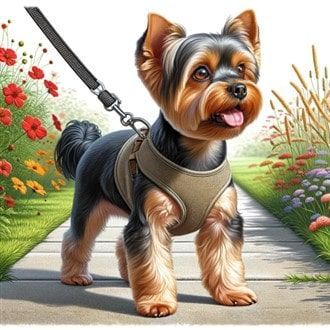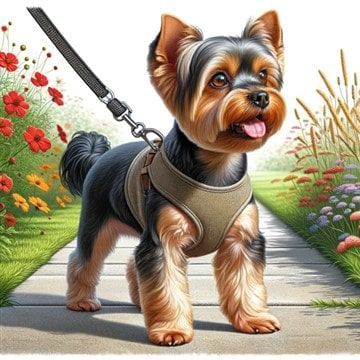Yorkshire Terrier Outdoor Care Guide: Tips for Puppies & Adults
Overview
This article provides insights into the common concerns and queries associated with taking a Yorkshire Terrier outdoors. It includes information on the ideal age for Yorkie puppies to start their outdoor adventures, essential safety tips for your yard and public areas, effective strategies to shield your little companion from predators such as hawks, and guidance on assisting your Yorkshire Terrier in coping with severe outdoor weather conditions.
Whether you have a new puppy or are seeking to enhance an existing outdoor regimen for your adult, you'll find valuable advice to ensure a happier and safer outdoor experience for your Yorkie.
Please note: YorkieInfoCenter is reader-supported. Some links below are affiliate links, meaning we may earn a small commission on products through these, at no extra cost to you.
The Age You Can Start Bringing a Yorkie Puppy Outside


The age at which you can safely start taking your Yorkie puppy outside varies from 6 to 16 weeks. Puppies initially have some disease protection from their mother's antibodies, which decrease as they grow. During this time, vaccinations begin to gradually build their own immunity. However, there's a vulnerable period when maternal antibodies wane before the puppy's vaccinations fully protect them.
The environment outside can expose your puppy to diseases like parvovirus, canine hepatitis, and leptospirosis, often spread through contact with contaminated areas from infected animals. The level of risk varies depending on the location (e.g., private yard vs. public park) and how your puppy is exposed to these areas, emphasizing the importance of following specific safety advice for outdoor exploration.
Let's look at the guidelines:
Outside in your own yard; Zero chance of other dogs, animals:
Outside of the house; Yorkie pup will NOT be placed on the ground:
While canine distemper is both an airborne disease (sneezing, coughing) as well as contracted via contact with contaminated surfaces, if a puppy is held by their owner, in a canine stroller or up in a carry pack, it is safe to have them out in public this way starting at 8 weeks old. Never, for even a moment, place them on the ground, even if it looks clean.
Out in public, on the ground:
Playing with other, known dogs:
If you have a friend, family member or neighbor that has a dog that you are 100% sure is both healthy and vaccinated, and you plan on very closely supervising the interaction, you may do so between the 2 and 4 month range. Some vets propose that this type of situation poses no risk (other than rough play, which is why you must supervise) and others like to play it very safe by suggesting owners wait until the pup is older and has had all of their puppy vaccinations.
Prepping Your Yard for Safety
The anticipation of taking your Yorkie outside for the first time is undoubtedly thrilling! However, pausing and preparing your outdoor space is essential to ensure it's safe for exploration.
- Yard Products: Be cautious of areas treated with lawn care chemicals, including weed killers and insecticides. The residues from these products can linger for varying durations, posing a risk to your pet. If you need clarification on the products used, contact the brand or the professional service that applied them for guidance. During winter months, also be mindful of salt and ice melt chemicals on surfaces, as they can cause paw burns and are toxic if ingested by your Yorkie.
- Obstacles and Hazards: Conduct a thorough check along the perimeter of your yard for potential dangers. This includes looking out for sharp objects like garden tools or sticks that may cause injury. Pay attention to small holes or uneven ground that could be trip hazards, as well as red ant hills or ground bee hives during warmer seasons.
- Fencing and Security: Verify that fences are secure, with no gaps or loose panels through which your Yorkie could escape. Ensure gates are properly latched and check for any digging spots along the fence line that could become potential escape routes.
- Toxic Plants: Familiarize yourself with and remove any plants that are toxic to dogs. Common garden plants like lilies, azaleas, and sago palms can be harmful if ingested.
- Water Features: If you have a pond, pool, or fountain in your yard, make sure your Yorkie cannot accidentally fall in. Consider fencing off these areas or closely supervising when they're nearby.
Taking these precautions will keep your Yorkie safe and give you peace of mind as you both enjoy the great outdoors together. Keep in mind, a little prep goes a long way in ensuring a fun and safe environment for your little guy or gal.
Safe Outdoor Practices: Navigating New Environments with Your Yorkshire Terrier


Introducing your Yorkshire Terrier to the vastness of the outdoors is an exciting venture that plays a crucial role in their development. However, the small stature and curious nature of Yorkies necessitate a mindful approach to ensure their safety and well-being. Here's how to guide your Yorkie through new outdoor environments effectively, focusing on their unique breed characteristics.
Start Small and Gradual: Begin with short outings in a controlled environment; good options are your backyard or a quiet park. Yorkshire Terriers, with their keen sense of curiosity, can easily become overwhelmed. Short, positive experiences help build their confidence gradually.
Harness and Leash Safety: For this breed, it's vital to use a harness instead of a collar when on a leash. Toy breeds like Yorkies are particularly susceptible to stress on their windpipe, which can be exacerbated by the concentrated pressure of a collar. A well-fitted harness vest like the EcoBark Step-in Harness circumvents this issue by distributing pressure evenly across the chest, back, and shoulders, ensuring both safety and comfort during walks.
Choose Safe Environments: Selecting the right environment is key. Avoid areas with heavy foot or vehicle traffic, and be cautious of places where larger dogs frequent. Yorkshire Terriers can be assertive but their small size puts them at a disadvantage in rough play or confrontations.
Socialization with Care: Socializing your Yorkie with other dogs and people should be a controlled and gradual process. Look for calm, friendly dogs and understanding people who can help reinforce positive social behaviors. Remember, positive experiences are crucial for your Yorkie's social skills.
Sensory Development: The outdoor world is rich with sounds, smells, and sights that can aid in your Yorkie’s sensory development. Encourage them to explore at their own pace, sniff around, and listen to the sounds, but always under your watchful eye to ensure they don’t ingest something harmful or venture too far.
Watch the Weather: Yorkshire Terriers are sensitive to extreme weather conditions. In hot weather, avoid asphalt that can burn their paws and ensure they have access to shade and water. In colder climates, consider a sweater or coat to keep them warm during short outdoor excursions. Please note: There is more info on clothing below, under the section of 'Dress for the Weather'.
Regular Health Checks: After outdoor activities, check your Yorkie for ticks, fleas, and any signs of discomfort. Regular grooming and veterinary check-ups are essential to catch any issues early and keep your Yorkie in top health.
Protecting Your Yorkshire Terrier from Predator Attacks
Yorkshire Terriers, with their small stature and adventurous spirits, are unfortunately at risk of wild animal attacks, including those from birds of prey such as hawks, eagles, and owls, as well as ground predators like coyotes and foxes. These animals may view small pets as prey, posing a significant threat, especially in areas where these predators are common. To protect your Yorkie, awareness and preparedness are key.
Never Leave Your Yorkie Unattended Outdoors: Small dogs can be at risk even in a fenced-in yard. Predators can scale or bypass fences, and birds of prey can swoop down from above.
Light Up the Night: Before letting your Yorkie out at dusk or after dark, turn on outdoor lights and use a flashlight to scan the yard for potential threats. This can help deter predators and give you a clear view.
Use a Short or Retractable Leash: Keeping your Yorkie close on walks limits their exposure to dangers and gives you more control in case of an encounter.
Opt for a Harness: A harness allows you to quickly lift your Yorkie away from danger without risking neck injury, providing a secure way to carry them to safety.
Carry Your Yorkie if Threatened: If you encounter an off-leash dog or wild animal, pick up your Yorkie. Do your best to remain calm and avoid direct eye contact with the potential threat, as this can be perceived as a challenge.
Noise as a Deterrent: An emergency whistle like the LuxoGear Emergency Whistle can effectively scare away a predator. The sudden loud noise might startle an attacking animal long enough for you to escape.
Carry a Legal Repellent: Consider having a non-lethal repellent with you as a last resort defense against an aggressive animal.
Walking Stick Strategy: Carrying a walking stick can offer a dual purpose: it's a physical barrier and a tool to fend off an attacker. Presenting the stick may divert an aggressive dog's attention from you or your pet.
Tips to Help a Yorkshire Terrier Tolerate Bad Weather: Rain, Snow and More


Yorkshire Terriers, with their petite size and coats of hair, can be particularly sensitive to harsh weather conditions. Whether it's the pouring rain, the biting cold of winter, or the scorching summer heat, ensuring your Yorkie remains comfortable and safe is paramount.
Below, we've compiled essential tips and strategies to help your Yorkshire Terrier navigate adverse weather conditions, focusing on practical solutions such as using protective gear and specialized products.
Dress for the Weather
Rain Coats for Wet Days: A waterproof raincoat is essential for keeping your Yorkie dry during those rainy walks. Look for raincoats with a comfortable fit that covers your dog's body without restricting movement. Reflective strips can enhance visibility during dark, overcast days. One that we like a lot is the Morezi Dog Raincoat which starts at size extra-small and will fit Yorkies from 5 to 10 lbs.
Winter Vests for the Cold: To tolerate the cold, a warm, insulated vest is crucial. Opt for winter gear that provides coverage from the neck to the base of the tail, ensuring it is snug to retain body heat without being too tight. Vests with water-resistant outer layers offer extra protection against snow and sleet.
A good one for toy breeds like the Yorkie is the Gyuzh Dog Coat with a Harness; We love this for many reasons including that the harness is built-in to the coat, so you just attach the leash to the d-ring on the coat. It has a warm fleece inner layer and a water-proof outer layer, so it's great for late fall through the winter. Note that this runs small, so the size small usually fits Yorkies in the 5-lb. range and the medium usually fits those in the 10-lb. range (but be sure to measure your Yorkie before ordering).
Addressing Intolerance to Rain
If your Yorkshire Terrier doesn't like going outside in the rain, there are some steps you can take to help with this.
A Rain Jacket: As mentioned previously under ‘Dress for the Weather’, a waterproof jacket can help quite a bit.
A giant umbrella: A large umbrella, particularly a golf umbrella, can serve as an excellent solution for keeping dry in the rain. These umbrellas are significantly larger than standard models, usually boasting a generous diameter ranging from 47 to 68 inches. This expansive coverage can ensure both you and your Yorkie remains protected from the elements, making it an ideal choice for rainy days. One that we like is the G4Free Automatic Open Golf Umbrella, which comes in a wide range of sizes and colors.
Start Small: Begin by introducing your Yorkie to light rain conditions, ideally during short walks or in your backyard. This sort of gradual exposure helps them become accustomed to the sensation of raindrops, reducing anxiety or fear associated with heavier downpours.
Positive Reinforcement: Use training treats and praise to create positive associations with rain. Encouraging your Yorkie with training treats and praise during and after wet weather outings reinforces rain as a positive experience.
Mimic Rain Sounds: If your Yorkie is particularly sensitive to rain, it may be due in part to the sound. You can help to desensitize them to this by playing recorded rain sounds at home. Start at a low volume and gradually increase it over time. This can help reduce noise-related anxiety during actual rainstorms.
Addressing Snow Storms
If your Yorkshire Terrier resists going outside in the snow, there are some things you can do to help make it more tolerable.
Dig a Path for Bathroom Breaks: In areas with heavy snowfall, it can help to clear a path in your yard for your Yorkie's bathroom needs. Deep snow can be intimidating and physically challenging for small breeds, so a cleared path encourages them to maintain their bathroom routine despite the snow.
Create a Sheltered Bathroom Area: If possible, set up a sheltered area where your Yorkie can go to the bathroom protected from snow and wind. This could be as simple as a tarp set up over a corner of an outdoor patio.
Use a Leash and Harness in Snowy Areas: In deep snow, always use a leash and harness on your Yorkie to prevent them from sinking or getting lost in the snow. The harness provides better control and ensures safety if you need to quickly lift your pet out of deep snow.
Avoid Salt and Chemical Melts: If you are not using a paw wax (highly recommend; see next tip) during winter walks, steer clear of areas where salt and chemical melts have been used, as these can irritate your Yorkie's paws and be toxic if ingested. After walks, wipe your dog's paws to remove any residues.
Protecting Paws and Nose
Paw Wax for All Seasons: Paw wax can safeguard your Yorkie's paws from hot pavements in summer and icy surfaces in winter. It acts as a barrier against heat, cold and irritants, while also providing added traction on slippery surfaces. A great one is Musher's Secret Paw Protection Wax; depending on how often your Yorkie is taken outside and for how long, this should be applied every 1 to 2 weeks.
Nose Balm for Harsh Weather: A dog's nose can suffer from extreme weather conditions in both summer and winter. A moisturizing nose balm can prevent sunburn during summer days and protect against chapping in cold weather. Choose a balm specifically designed for dogs to ensure it's safe if licked. One that we like a lot is Snout Soother; this one is a small Chapstick-like container which makes it very easy to apply.
Indoor Exercise Alternatives
When faced with poor weather conditions, it's essential to explore indoor activity options to keep your Yorkshire Terrier busy and engaged. Here are some effective strategies:
Interactive Toys: Utilize interactive toys that stimulate your Yorkie's mind and encourage some movement. A snuffle mat is an excellent tool for this; it engages a Yorkshire Terrier's natural foraging instincts. Essentially, it is a thick, fabric mat that contains numerous flaps and folds where you can hide dry treats or kibble. As your Yorkie sniffs and searches through the mat to find the hidden rewards, they get mental stimulation and a sense of accomplishment from their "hunting" efforts. One that we like is the Snuffle Mat for Dogs by Meilzer; it's small enough to easily tuck away when not in use but has lots of fun loops and flaps to hide goodies.
Indoor Fetch: A simple game of fetch in a hallway or spacious room not only can deliver a good amount of physical exercise but can also strengthens the bond between you and your Yorkie through playful interaction. Additionally, engaging in such activities helps stimulate a Yorkie's mind, keeping them mentally sharp and potentially mitigating any signs of boredom or anxiety that can arise from being indoors for extended periods.
Agility Courses: Create a mini agility course using household items to weave through, blankets over chairs for tunnels, and small boxes to jump over. This not only exercises their body but also sharpens their cognitive skills.
Hide-and-Seek Games: Engage in hide-and-seek by hiding yourself or your Yorkie's favorite toys around the house. This game stimulates their natural hunting instincts and provides both mental and physical activity.
You will find more details about these and other activities in our Yorkshire Terrier Exercise Requirements article.
More Articles:
Yorkshire Terrier Do and Don't List - A super-helpful concise guide on the most important do's and the most vital don'ts for this amazing toy breed. How many are you following?
My Yorkie is Eating Poop - Why coprophagia develops in puppies and dogs and exact steps to stop this behavior in a gentle, loving manner.
How to Get a Yorkie to Listen - Helpful tips and strategies if your Yorkie is being stubborn and won't listen to your commands.
